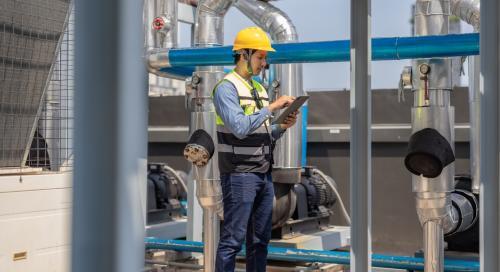By Rachel Powis (MSc, CertOH., LFOH)
Technical Manager, Occupational Hygiene
Workplace Exposure Limits (WELs) form a fundamental part of the UK Control of Substances Hazardous to Health (COSHH) regulations, and are a critical regulatory measure designed to protect workers from exposure to hazardous substances in the workplace. However, demonstrating compliance with these exposure limits can pose significant challenges both for employers and businesses.
Understanding Workplace Exposure Limits
WELs are legally-binding exposure limits for specific substances in the workplace, measured in parts per million (ppm) or milligrams per cubic metre (mg/m³) averaged over a defined period - typically 8-hours for long-term exposure, or 15-minutes for short duration exposure. The Health and Safety Executive (HSE) sets these limits as part of regulations limit exposure to airborne hazardous substances.
Although not all hazardous substances have WELs, this does not mean unlimited exposure is safe. In order to comply with regulations, employers and businesses must ensure that exposure is adequately controlled, that control is proportional to health risk, and that in the case of carcinogens, mutagens and asthmagens, exposure is controlled to As Low As Reasonably Practicable (ALARP). Therefore, compliance with regulations as a whole must go beyond demonstrating WELs compliance alone.
The Core Challenges of Demonstrating Compliance
There are several core challenges when it comes to demonstrating WEL compliance, and many businesses struggle due to the complex nature of monitoring, documenting, and maintaining exposure controls. Key issues include:
- Accurate Monitoring: Monitoring of airborne substances is necessary, but interpreting and obtaining accurate data can be technically demanding. Exposure levels vary widely due to various internal and external factors such as different production processes, environmental conditions or workload, leading to significant day-to-day fluctuations which are rarely represented in one-day sampling events.
- Variability in Exposure Levels: Compliance is easier to demonstrate with extreme exposure profiles, but becomes complex within lower ranges. This requires further monitoring and statistical analysis, typically only gained by collecting exposure data over multiple days or even months. However, these additional efforts can be prohibitively expensive and often offers no further benefit where the goal is to ensure adequate control and protect worker health.
- Complexity of Substances: Many workplaces can be exposed to a variety of hazardous substances, each with its own exposure limit. Managing risk from multiple hazards simultaneously, particularly in dynamic environments, is an additional complexity. In fact, exposure to a range of chemicals can have an additive, or even synergistic effect, posing interpretation challenges when it comes to sufficient compliance efforts.
- Differing International Standards: In a number of cases WELs don’t always align with international exposure limits or health based guidelines, a discrepancy which poses a particular challenge for global businesses. These businesses must often prioritise local Occupational Exposure Limits (OELs) which may be stricter, and therefore must do more than simply meeting WEL compliance.
Effective Occupational Hygiene Practice
Addressing these challenges requires a comprehensive approach that goes beyond sampling data, and often involves reviewing existing control measures with the Principles of Good Practice in mind. Effective occupational hygiene practice for wider regulatory compliance can include the following:
- Regular Monitoring: Regular reassessments of airborne concentrations and performance of existing controls help track exposure profiles. Air quality testing, both short-term and long-term, is valuable in maintaining compliance, especially in environments where exposure fluctuates.
- Detailed Documentation: Employers should develop a systematic approach to record-keeping. Comprehensive documentation of monitoring activities, assessments, maintenance and training records, and any assessment of the effectiveness of control measures implemented is essential for regulatory audits.
- Effective Control Measures: Engineering controls (such as ventilation systems), administrative controls (such as rotating job roles to limit exposure time), and personal protective equipment (PPE) can all help control exposure.
- Stay Updated with Best Practice: Employers should establish processes to monitor updates from the HSE and industry bodies regarding good practices and technical developments in the industry, ensuring their strategic approaches remain current.
More than ever, engaging with occupational hygiene professionals and seeking their expertise can help businesses navigate the complexities of workplace exposures and ensure that their employees are adequately protected. With extensive experience in occupational hygiene, Envirochem’s services are tailored to help you navigate compliance complexities effectively. We provide actionable strategies and continuous improvement initiatives designed to meet your specific needs, ensuring better health outcomes for your employees and enhancing overall business performance.
Conclusion
Addressing workplace exposures presents immediate challenges for businesses, yet it also offers long-term benefits for workforce health and operational efficiency. But whilst compliance with WELs is an important aspect of protecting workers from hazardous substances, it is not the sole indicator of occupational health and safety performance, and employers have a responsibility to go beyond these limits. By proactively addressing these challenges head-on, employers can ensure a more comprehensive approach to managing hazardous substances and protecting the health and safety of their workers, whilst delivering sound compliance with the COSHH regulations.
For tailored advice and actionable strategies to combat the challenges of WEL compliance, get in touch with one of our experts.
Author
Related Content
How can we help?
Contact UsWebsite Privacy Policy - Privacy Notice - Terms & Conditions
© Envirochem Analytical Laboratories Ltd
Reg. No. 2378228 England


-(1)_page-0001.jpg)
